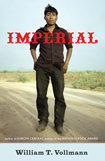Each day leading up to the March 11 announcement of the 2009 NBCC award winners, Critical Mass highlights one of the thirty finalists. Today, NBCC board member David L. Ulin discusses nonfiction finalist William T. Voll mann's Imperial (Viking)
mann's Imperial (Viking)
What is the line between myth and history? Where is the middle distance between folklore, fiction and reportage? Such questions reside at the heart of William T. Vollmann’s Imperial, a massive, multi-layered look at the border region of southeastern California, from the Colorado River to the Coachella Valley, Mexicali to the Salton Sea—an area that roughly corresponds with Imperial County, but really exists more fundamentally in Vollmann’s mind. Here, Vollmann explicates the history of Califorina, and by extension, of the United States, by looking at one particular piece of territory, a landscape that by virtue of geography and climate, can be read as emblematic of many issues and ideas.
For Vollmann, nothing is more essential than immigration and water—and why not, since they have long defined the political and cultural life of California, where he lives? Indeed, more than any of his previous books, Imperial is the work in which Vollmann establishes himself as a California writer, one concerned with untangling the state’s most ancient themes. Or no … not untangling, for Vollmann is too incisive to believe that there is a solution, that there is any way for things to be resolved. Rather, he operates as a literary recorder, observing both sides of the border with his distinctive blend of empathy and detachment, marking down what he sees as if only in the slow accretion of detail will we ever have even the slightest sense of where we are. This is the key to Imperial, to accept that it offers no epiphanies but rather attempts to re-create in language the unresolved nature of the place: sprawling, kaleidoscopic, unstuck in time.
To pull this off, Vollmann must constantly blur the boundaries, considering everything from current immigration policy to the lingering aftershocks of the booster myth. He must juxtapose the competing mythologies of Northside (the United States) and Southside (Mexico), while finding a new way to map what he finds. But this, too, is part of the point here, for Vollmann has long been fascinated by the concept of delineation, by the frames we put around things to explain them to ourselves. “It may be,” he writes, “that since this southeast corner of California is so peculiar, enigmatic, sad, beautiful and perfect as it stands, delineation of any sort should be foregone in favor of the recording of ‘pure’ perceptions, for instance by means of a camera alone; or failing that, by reliance on word-pictures: a cityscape of withered palms, white tiles, glaring parking lots, and portico-shaded loungers who watch the boxcars groan by; a cropscape of a rich green basil field, whose fragrance rises up as massively resonant as an organ-chord.”
Click here to read an excerpt from Imperial.


